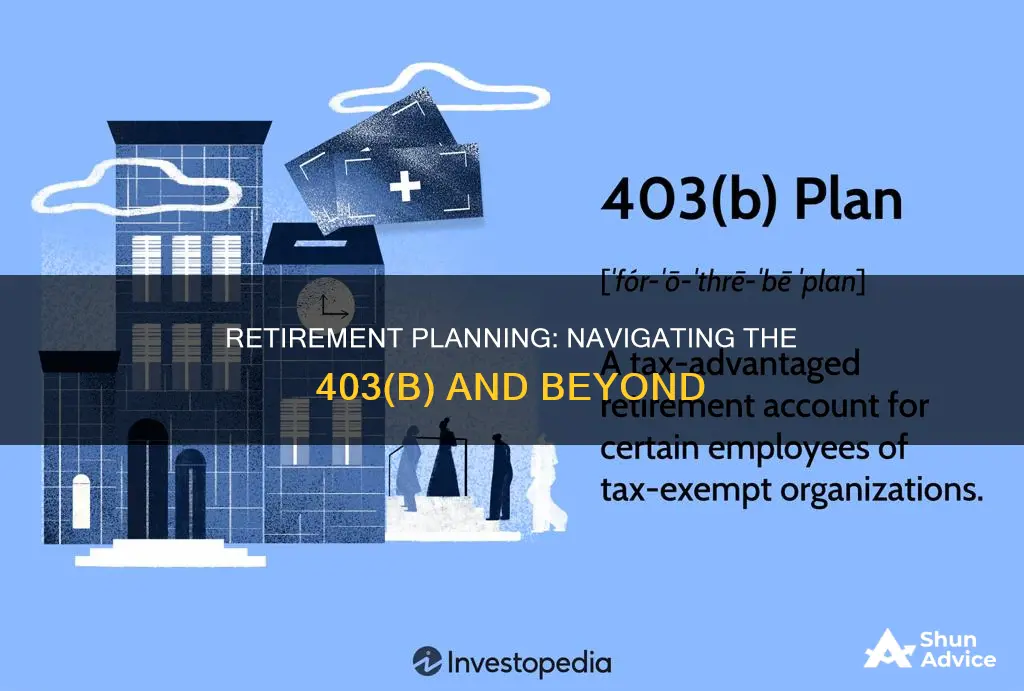
If you work in the public sector or for a non-profit organisation, you may be offered a 403(b) plan as part of your employee benefits package. A 403(b) plan is a retirement plan that allows employees to contribute some of their salary to the plan, with the option for the employer to contribute too. It is similar to a 401(k) plan, but with a few key differences. So, which is the best option for you?
What You'll Learn

Pros and cons of a 403(b) plan
A 403(b) plan is a retirement plan offered by public schools, non-profit organisations, churches, and other tax-exempt entities. It is designed for employees of these organisations, including teachers, school administrators, professors, government employees, nurses, doctors, and librarians.
Pros of a 403(b) plan:
- Tax advantages: The money contributed to a 403(b) plan is often pre-tax, reducing taxable income for the current year. Taxes are paid when funds are withdrawn during retirement, when most people will be in a lower tax bracket.
- High contribution limits: The contribution limits for 403(b) plans are much higher than for IRAs. In 2023, individuals could contribute up to $22,500, increasing to $23,000 in 2024. Those aged 50 and over can make additional "catch-up" contributions of up to $7,500.
- Employer matching: Employers may match employee contributions up to a certain percentage of their salary.
- Shorter vesting schedules: Vesting schedules determine when employer-matched funds can be kept by the employee. 403(b) vesting schedules are typically shorter than those for 401(k) plans, and some even offer immediate vesting.
- Extra catch-up contributions: In addition to the standard catch-up contributions for adults aged 50 and over, 403(b) plans allow participants who have worked for the same employer for at least 15 years to contribute up to $3,000 per year in additional funds.
- Flexibility in contributions: 403(b) plans have high contribution limits, allowing for greater investment than an IRA.
- Optional loans and hardship distributions: While withdrawals before the age of 59 1/2 typically incur a penalty, there are exceptions for loans and certain hardship withdrawals.
Cons of a 403(b) plan:
- Few investment choices: 403(b) plans have more limited investment options compared to 401(k) plans or IRAs. The money can generally only be invested in annuities or mutual funds.
- High fees: Some 403(b) plans charge high fees that can eat into profits.
- Penalties on early withdrawals: Withdrawing funds before the age of 59 1/2 will typically incur a 10% early withdrawal penalty in addition to taxes, unless there is a qualifying reason.
- Not always subject to ERISA: The Employee Retirement Income Security Act (ERISA) sets minimum standards for retirement plans to protect employees. However, many 403(b) plans are not subject to ERISA, so additional research may be required to decide if it is a good home for your money.
- Potential administrative costs: 403(b) plans often have higher administrative costs than IRAs.
Disney Stock: Buy or Bye?
You may want to see also

Who can invest in a 403(b) plan?
A 403(b) plan is a tax-advantaged retirement plan that is typically offered to employees at public schools, colleges, universities, and certain tax-exempt organisations, including churches and charities.
Eligible employees include:
- Teachers
- School administrators
- Professors
- Government employees
- Nurses
- Doctors
- Librarians
- Ministers and clergy members
- Self-employed ministers
- Chaplains
Part-time workers can participate in a 403(b) plan, provided they work at least 20 hours per week, contribute at least $200 per year, and are not participating in another 403(b) plan.
Oil Investing: Smart Move?
You may want to see also

How does a 403(b) plan work?
A 403(b) plan is a retirement plan offered by specific employers to their employees. These employers include public schools, certain tax-exempt organisations, and churches. The plan allows employees to contribute a portion of their salary to the plan, and the employer may also contribute.
The 403(b) plan is similar to a 401(k) plan, but there are some differences. Like a 401(k) plan, a 403(b) plan offers tax-deferred growth on savings contributions, high annual contribution limits, and two plan types: traditional and Roth. However, 403(b) plans differ in that they are offered by certain government, nonprofit, and religious organisations, while 401(k) plans are offered by for-profit companies. Additionally, 403(b) plans offer a catch-up contribution option that 401(k) plans do not.
The traditional 403(b) plan is funded with pre-tax dollars, which provides an upfront tax write-off for the tax year that deposits are made. Withdrawals from a traditional 403(b) plan are taxed as ordinary income. On the other hand, Roth 403(b) plans are funded with after-tax dollars, and qualified distributions are not taxed.
Employees can choose how much they want to contribute to the 403(b) plan, either a percentage of their salary or a set dollar amount, and this money is then taken out of their paycheck and invested in the chosen options. Employers can also contribute to their employees' 403(b) plans, which is called a "match". It is generally a good idea to take advantage of the employer match, as it is a part of the compensation offered for the position.
There are some important considerations regarding 403(b) plans. These plans usually offer fewer investment choices than 401(k) plans and may be loaded with insurance products like annuities with low returns, expensive fees, and surrender charges. It is recommended to steer clear of these options and stick with good growth stock mutual funds. Additionally, 403(b) plans have contribution limits, early withdrawal penalties, and tax implications. It is important to carefully evaluate the annual fees and costs associated with a 403(b) plan before signing up.
Cramer's Investing Club: Strategies and Secrets
You may want to see also

What are the tax implications of a 403(b) plan?
A 403(b) plan is a retirement plan that offers certain tax benefits to employees. Here are the key tax implications to consider:
Tax-Sheltered Contributions
B) plans allow employees to contribute a portion of their salary to their retirement accounts on a tax-sheltered basis. This means that contributions are made with pre-tax dollars, reducing the taxable income for the current year. The deferred salary is generally not subject to federal or state income tax until it is distributed during retirement. This results in tax-deferred growth within the 403(b) plan.
Traditional vs. Roth 403(b)
The 403(b) plan offers two main options: traditional and Roth. A traditional 403(b) allows employees to make pre-tax contributions, lowering their gross income and income tax for the contribution year. On the other hand, a Roth 403(b) requires after-tax contributions, providing no immediate tax advantage. However, with a Roth 403(b), employees won't owe any additional taxes on the money or its profits when they withdraw it during retirement.
Catch-up Contributions
The 403(b) plan provides catch-up contribution options for employees. In addition to the standard catch-up contributions for individuals aged 50 and older, the plan allows participants who have worked for the same employer for at least 15 years to make extra catch-up contributions. These additional contributions can be up to a certain limit, depending on the specific plan.
Early Withdrawal Penalties
Funds withdrawn from a 403(b) plan before the age of 59 1/2 are typically subject to a 10% early withdrawal penalty, in addition to regular income taxes. However, there are certain exceptions to this penalty, such as qualifying medical expenses, disability, or separation from employment after the age of 55.
Employer Contributions
Employers can also contribute to their employees' 403(b) plans, often through matching contributions. These employer contributions are generally made with pre-tax dollars and are not taxed until they are withdrawn by the employee during retirement.
Investment Options and Taxes
The investment options within 403(b) plans may be limited compared to other retirement accounts. Annuities and mutual funds are common investment choices within these plans. The tax treatment of investment gains within the plan will depend on the type of 403(b) (traditional or Roth) selected by the employee.
Why Pay for Aaii Membership?
You may want to see also

How does a 403(b) plan compare to a 401(k) plan?
A 403(b) plan is a type of retirement account available to individuals working in the public education sector and employees of certain tax-exempt organisations. It is similar to the more common 401(k) account, which is usually offered by employers in the private sector.
Both plans enable employees to defer a portion of each paycheck for their retirement, and employers may choose to match some of their employees' contributions. They also share the same contribution limits and tax advantages. However, there are some key differences:
- A 403(b) plan is available to government employees, medical professionals, librarians, self-employed ministers, and employees of public schools such as teachers and administrators. 401(k) plans are for employees of companies in the private sector.
- 403(b) plans originally restricted participants to investing in tax-sheltered annuities, but this was loosened in 1974 to allow for a choice of mutual funds. 401(k) plans usually offer a wider choice of investments, including mutual funds, stocks, bonds, and other securities.
- 403(b) plans may not have to comply with all the regulations in the Employee Retirement Income Security Act (ERISA).
- 403(b) plans often have shorter vesting schedules than 401(k) plans, and some even offer immediate vesting.
- 403(b) plans have an additional "Special Catch-Up" provision that allows participants who have worked for the same employer for at least 15 years to contribute up to $15,000 over their career.
- 403(b) plans are typically administered by insurance companies, while 401(k) plans are usually administered by mutual fund companies.
Mutual of America: Worth the Investment?
You may want to see also
Frequently asked questions
A 403(b) plan is a retirement plan offered by public schools and certain tax-exempt organisations. It is similar to a 401(k) plan but is only available to employees of public schools, colleges, universities, and certain non-profit organisations.
Typically, 403(b) plans are available to employees of public schools, state colleges, universities, public school employees of Indian tribal governments, employees of tax-exempt organisations, and certain ministers.
403(b) plans offer tax advantages, high contribution limits, employer matching, shorter vesting schedules, and extra catch-up contributions.
403(b) plans may have few investment choices, high fees, penalties on early withdrawals, and they may not be subject to ERISA (Employee Retirement Income Security Act).
You choose how much money you want to contribute to the plan, either a percentage of your salary or a set dollar amount, and that money is taken out of your paycheck and invested in the options you choose. Employers can also contribute to your account.







